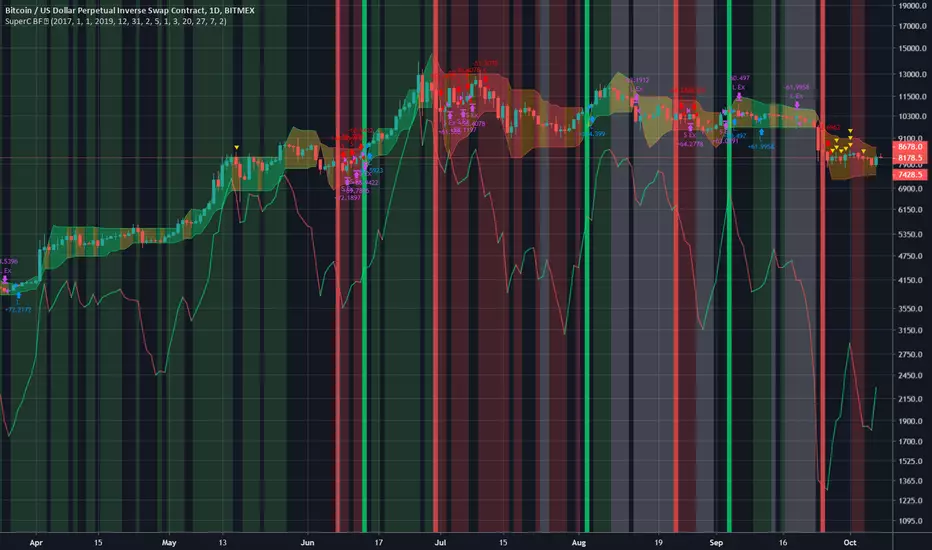OPEN-SOURCE SCRIPT
SuperC BF 🚀

Based on some code from noro and kiasaki - thank you.
A Super Trend is a trend over a long period of time. There are lots of existing scripts that generate signals based on the overall direction of an instrument. What if we combined this idea with a measure of Money Flow and added a filter to try to avoid choppy sideways action?
I started with a super trend foundation and added an MFI calculation to account for volume flowing into and out of the asset. Then added a Rate of Change function to stay out of trades when there is not much up/down movement.
INSTRUCTIONS
COLOR OVERVIEW
A white background means we don't trade
A green background means we have a long condition
A red background means we have a short condition
The cloud is green when we have a long condition, red when we have a short condition.
The cloud is yellow if we should be in a long already but the current candle is not satisfying all long conditions.
The cloud is orange if we should be in a short already but the current candle is not satisfying all short conditions.
The line at the bottom is MFI - this is green when the current candle is greater than the last, red when it is less than the last.
SIGNAL GENERATION
A long condition is when MFI > MFI[1] AND we are not in a choppy market AND when price is above the super trend.
A short condition is when MFI < MFI[1] AND we are not in a choppy market AND when price is below the super trend.
We use a fixed Stop Loss of 2% here on the daily timeframe for XBT/USD.
If we get stopped out from a long and we still have the conditions for a long, we re-enter. Same for short.
A Super Trend is a trend over a long period of time. There are lots of existing scripts that generate signals based on the overall direction of an instrument. What if we combined this idea with a measure of Money Flow and added a filter to try to avoid choppy sideways action?
I started with a super trend foundation and added an MFI calculation to account for volume flowing into and out of the asset. Then added a Rate of Change function to stay out of trades when there is not much up/down movement.
INSTRUCTIONS
- Bright green background = go long
- Bright red background = go short
COLOR OVERVIEW
A white background means we don't trade
A green background means we have a long condition
A red background means we have a short condition
The cloud is green when we have a long condition, red when we have a short condition.
The cloud is yellow if we should be in a long already but the current candle is not satisfying all long conditions.
The cloud is orange if we should be in a short already but the current candle is not satisfying all short conditions.
The line at the bottom is MFI - this is green when the current candle is greater than the last, red when it is less than the last.
SIGNAL GENERATION
A long condition is when MFI > MFI[1] AND we are not in a choppy market AND when price is above the super trend.
A short condition is when MFI < MFI[1] AND we are not in a choppy market AND when price is below the super trend.
We use a fixed Stop Loss of 2% here on the daily timeframe for XBT/USD.
If we get stopped out from a long and we still have the conditions for a long, we re-enter. Same for short.
Open-source script
In true TradingView spirit, the creator of this script has made it open-source, so that traders can review and verify its functionality. Kudos to the author! While you can use it for free, remember that republishing the code is subject to our House Rules.
Disclaimer
The information and publications are not meant to be, and do not constitute, financial, investment, trading, or other types of advice or recommendations supplied or endorsed by TradingView. Read more in the Terms of Use.
Open-source script
In true TradingView spirit, the creator of this script has made it open-source, so that traders can review and verify its functionality. Kudos to the author! While you can use it for free, remember that republishing the code is subject to our House Rules.
Disclaimer
The information and publications are not meant to be, and do not constitute, financial, investment, trading, or other types of advice or recommendations supplied or endorsed by TradingView. Read more in the Terms of Use.